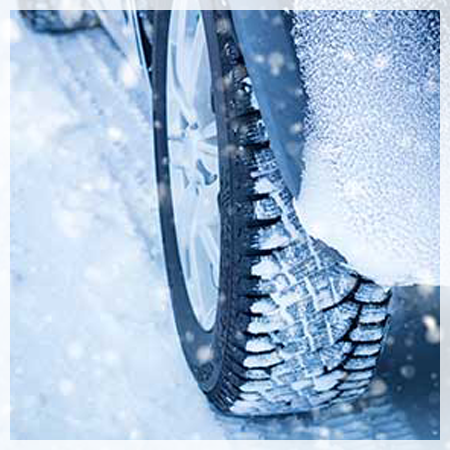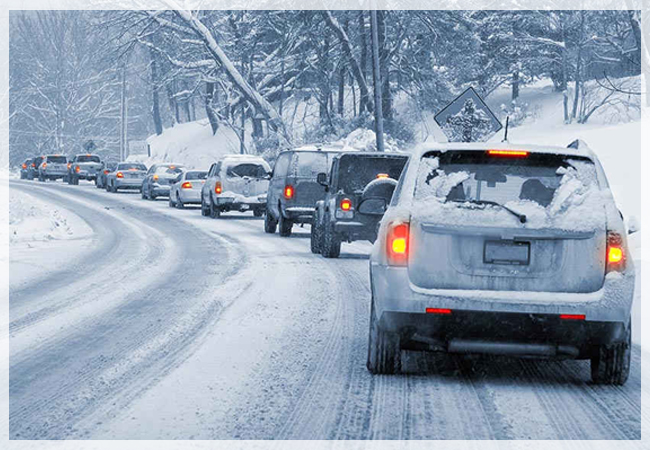Currency
December 10, 2017

Winter is here, and many regions will be experiencing ice and snow on the roads. Winter weather conditions make driving more hazardous; according to the National Highway Traffic Safety Administration, 17 percent of winter-weather motor vehicle accidents occur during snow or sleet, 13 percent on icy pavement, and 14 percent on snowy or slushy pavement. These tips can help you prepare, protect, and prevent against winter-weather accidents as well as give guidelines on what to do if something does happen to you.
** Keep an eye on not only your local weather, but the weather of your destination when making a trip.
** Inspect your vehicle to determine that your systems are working properly.
** Brakes: Brakes should provide even and balanced braking. Also check that brake fluid is at the proper level.
** Cooling system: Ensure a proper mixture of 50/50 antifreeze and water in the cooling system at the proper level.
** Electrical system: Check the ignition system and make sure that the battery is fully charged and that the connections are clean.
** Check that the alternator belt is in good condition with proper tension.
** Engine: Inspect all engine systems.
** Exhaust system: Check exhaust for leaks and that all clamps and hangers are snug.
**Tires: Check for proper tread depth and no signs of damage or uneven wear. Check for proper tire inflation.
** Oil: Check that oil is at proper level.
** Visibility systems: Inspect all exterior lights, defrosters (windshield and rear window), and wipers. Install winter windshield wipers.
Create an emergency kit containing a cell phone or two-way radio, flashlight, jumper cables, abrasive material (sand, kitty litter, etc.), shovel, snow brush and ice scraper, emergency flares, and blankets. For longer trips, add food, water, and any medications.

Practice cold-weather driving. During daylight, rehearse maneuver slowly on the ice or snow in an empty lot. Steer into a skid, and know what how to handle your brakes: you should stomp on antilock brakes and pump non-antilock brakes. Remember that stopping distances are longer on water-covered ice and ice. Don't idle for a long time with the windows up or in an enclosed space.
** Always wear a seat belt.
** Use child safety seats properly.
** Never place a rear-facing infant seat in front of an air bag.
** Children 12 and younger are much safer sitting in the back seat.
** Never mix drugs or alcohol with driving.
** Slow down and increase the distance between cars—remember, stopping distances are longer on ice.
** Keep your eyes open for pedestrians walking in the road.
** Avoid fatigue by getting plenty of rest before the trip, stopping at least every three hours, and rotating drivers if possible.
** Designate a sober driver if anyone in the vehicle is planning to drink.
** If you're stopped or stalled, stay with your car, don't over exert yourself, put bright markers on antenna or windows and shine dome light, and, if you run your car, clear exhaust pipe and run it just enough to stay warm.
** If you're stranded, watch for signs of frostbite and hypothermia. Do minor exercises to maintain good blood circulation in your body, and clap your hands and move your arms and legs occasionally. Try not to stay in one position for too long. Stay awake, as that will make you less vulnerable to cold-related health problems. Use blankets, newspapers, maps, and even car mats for added insulation. Avoid overexertion since cold weather puts an added strain on the heart.
Prepare for Your Drive
** Keep an eye on not only your local weather, but the weather of your destination when making a trip.
** Inspect your vehicle to determine that your systems are working properly.
** Brakes: Brakes should provide even and balanced braking. Also check that brake fluid is at the proper level.
** Cooling system: Ensure a proper mixture of 50/50 antifreeze and water in the cooling system at the proper level.
** Electrical system: Check the ignition system and make sure that the battery is fully charged and that the connections are clean.
** Check that the alternator belt is in good condition with proper tension.
** Engine: Inspect all engine systems.
** Exhaust system: Check exhaust for leaks and that all clamps and hangers are snug.
**Tires: Check for proper tread depth and no signs of damage or uneven wear. Check for proper tire inflation.
** Oil: Check that oil is at proper level.
** Visibility systems: Inspect all exterior lights, defrosters (windshield and rear window), and wipers. Install winter windshield wipers.
Create an emergency kit containing a cell phone or two-way radio, flashlight, jumper cables, abrasive material (sand, kitty litter, etc.), shovel, snow brush and ice scraper, emergency flares, and blankets. For longer trips, add food, water, and any medications.

Practice cold-weather driving. During daylight, rehearse maneuver slowly on the ice or snow in an empty lot. Steer into a skid, and know what how to handle your brakes: you should stomp on antilock brakes and pump non-antilock brakes. Remember that stopping distances are longer on water-covered ice and ice. Don't idle for a long time with the windows up or in an enclosed space.
Protect Yourself
** Always wear a seat belt.
** Use child safety seats properly.
** Never place a rear-facing infant seat in front of an air bag.
** Children 12 and younger are much safer sitting in the back seat.
Prevent Crashess
** Never mix drugs or alcohol with driving.
** Slow down and increase the distance between cars—remember, stopping distances are longer on ice.
** Keep your eyes open for pedestrians walking in the road.
** Avoid fatigue by getting plenty of rest before the trip, stopping at least every three hours, and rotating drivers if possible.
** Designate a sober driver if anyone in the vehicle is planning to drink.
What to Do if Something Happens
** If you're stopped or stalled, stay with your car, don't over exert yourself, put bright markers on antenna or windows and shine dome light, and, if you run your car, clear exhaust pipe and run it just enough to stay warm.
** If you're stranded, watch for signs of frostbite and hypothermia. Do minor exercises to maintain good blood circulation in your body, and clap your hands and move your arms and legs occasionally. Try not to stay in one position for too long. Stay awake, as that will make you less vulnerable to cold-related health problems. Use blankets, newspapers, maps, and even car mats for added insulation. Avoid overexertion since cold weather puts an added strain on the heart.









